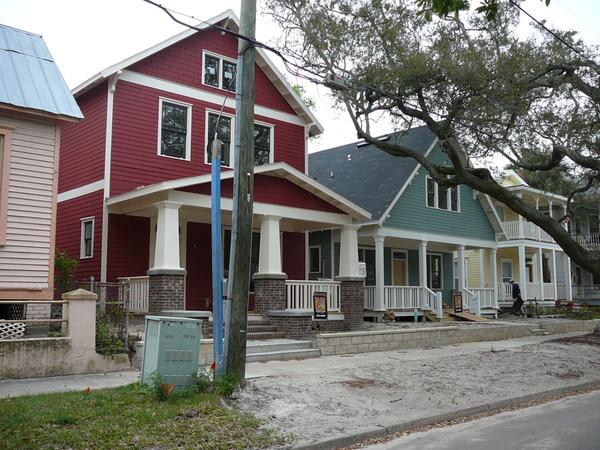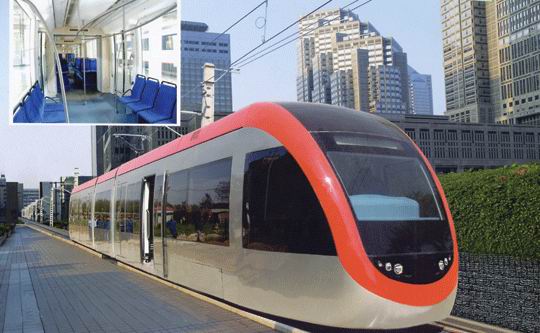Let's get straight to the issue surrounding COTPA's Let's Talk Transit forums. What people want to know is the route of the proposed streetcar system, when it's going to be built, and issues like that.
If you're still back on Page 1 and wondering what kind of rail we're doing and questions like that, just research "streetcar." Throw out everything you know about heavy rail, commuter rail, light rail, etc--those types of mass transit are not designed to work effectively and safely within pedestrian spaces, do not make quick stops, travel too fast, and are cost prohibitive for a condensed (LOL at that one) downtown area. Streetcar is a cost-effective option that is also clearly the best-adapted to what we hope may at some point in the future be a good pedestrian area.
Now moving on. The route. That is the real issue, and probably one of the most complex issues that remain unresolved with MAPS 3 (besides how a powerless advisory board can possibly be relevant in anyway). It involves many complex issues, and possibly politics although I hope it doesn't come down to that.
Because of streetcar's incredible ability to stimulate infill development within 4 blocks of a streetcar line, you have to look at the potential of certain key nodes of activity in downtown, and not just what is presently there. With that said, you also want a good mix of current hotspots such as Bricktown, the Devon Tower site, Ford Center/Cox Center, etc. In my opinion the goal should be to maximize the best mix of potential infill stretches that link current hotspots. One example is the area between the CBD and the Walker Circle in MidTown, another example is the area between Bricktown and the OUHSC/Oklahoma Health Center area.
I would also encourage anyone looking at a route to heavily consider the potential to expand the system. For instance, if you go with a certain route, consider how an expansion to further-out important activity areas (such as perhaps the State Capitol, OCU, etc) would tie-in with what you're creating.
Then there are technical ramifications. Consideration of locating a hub for the system. What type of route configuration, are we going to go with a loop system, or a hub-and-spoke? I tend to prefer the loop because it's simple and incredibly easy to expand, difficult to mess up from a planning perspective--and with planning being what it is in the Heartland you definitely want to minimize the risk in that area. The mayor seems to prefer the hub-and-spoke system based off of what has been in the media, and I'm not one to question the planning expertise of Mayor Cornett. Actually though, the hub-and-spoke does offer a few advantages, the most important being that it seems you can cover more of downtown using the same 5-6 mile distance of track. That is a clear advantage that could make hub-and-spoke the best option for OKC if it chose to go in that direction with the streetcar project.
Like I mentioned, a loop route would be almost too easy. A hub-and-spoke system would require heavy coordination of tying in the different streetcar lines, a schedule that is a work of art, and of course it would require that every line be a double track.
Here's an interesting hub-and-spoke route that I put together. There are three overall lines: the Blue Line is just a strip down Sheridan Ave, the Red Line is just a loop that goes through MidTown and ties into..the Orange Line, which connects downtown and Bricktown to the OUHSC area and closely resembles the abstract route proposed by the Modern Transit Project led by Jeff Bezdek.

This is a good route in my opinion because it does a good job of tying sites that currently have high importance with areas that could see a lot of infill. The infill is important because that is almost the only area in which OKC stands to get an economic benefit out of streetcar, and the economic impact of downtown development shouldn't be underestimated. The areas in this system that would see a ton of infill are along Sheridan in the Film Row area, the "Medical Business District" along 10th Street, the area along Walker before you get to the Walker Circle, and also the area along Lincoln would stand to be built up.
The system also ties in a good array of important sites, starting with the hub which would be placed at Santa Fe Station. In the past I've talked about the opportunity to expand the Santa Fe Depot and build a true transit hub that ties into the east side of the Cox Center (which is currently an embarrassing blank wall), but it's the same general area. Realistically with streetcar, you don't need a hub, but it can be a valuable bonus to tie the streetcar into Amtrak, potential light rail/commuter rail to other parts of the city, bus services, among other modes of transportation. Other important sites that are linked by this system are Bricktown (from end to end), the OUHSC, Devon Tower, the Cox Center/Ford Center, Myriad Gardens, and OCU Law School along the Blue Line and the OUHSC leg of the Orange Line. The Red Line connects the Arts District, City Hall, Civic Center Music Hall, OKC Museum of Art, Walker Circle (restaurants), and so on. The Orange Line goes all the way down North Broadway and feeds off of the Automobile Alley area--imagine how awesome streetcar will look gliding along its rails with the historic storefronts of A-Alley behind it and the CBD skyline off in the distance.
And then, as for tie-in to potential expansion, here's what I've got in mind:

You can see where the goal here is mainly to connect the one remaining big activity area (the State Capitol) to the rest of the system and for the rest of the expansions, I think the best idea is to follow historic precedent. There are certain historic areas of our city that were originally built around streetcar expansions in the first place and these areas today still offer the best chance for success. For the most part, these are also the denser, cooler strips that could use a real hand in redevelopment--such as the Plaza District or Uptown. Future streetcar expansions should connect hot spots such as OCU, 23rd Street, the Asian District, Uptown, Plaza District, perhaps Western Avenue, Paseo, etc. Imagine the diversity that someone from out of town would come in contact with simply by riding the streetcar of OKC.












